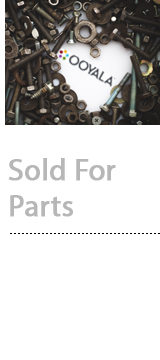
Video ad platform Ooyala is slowly being disassembled and sold piece by piece.
On Thursday, Ooyala revealed it had sold its online video player to Brightcove for $15 million. The deal is expected to close in mid-2019.
Brightcove, founded in 2004, provides a similar cloud-based video distribution solution as Ooyala. Its clients include Acorn TV, Lowes, Dunkin’ and Wendy’s.
Like many ad tech companies, Ooyala was once flying high. Founded in 2007 by ex-Google executives, Ooyala raised a total of $123 million before being acquired by Australian telco Telstra in 2014. Telstra bought the company in two installments for a total of $500 million.
But things quickly went south.
In September 2018, Ooyala sold its ad tech business to Invidi, the addressable TV platform owned by AT&T, WPP and Dish. By October, Telstra had taken a $500 million write-down on the deal and sold the rest of Ooyala back to its founders, publicly admitting the acquisition had failed and exiting the ad tech business.
Ooyala continues to operate its media logistics business, Ooyala Flex, independently.
“With this transaction we’re ushering in an exciting new chapter for our company, as we continue to focus and expand on Ooyala’s flourishing workflow and media-asset-management solutions,” said Ooyala CEO Jonathan Huberman in an email.
What went wrong?
Telstra had big ambitions to turn Ooyala into a multi-billion business in the burgeoning online video space. Under the telco, Ooyala acquired supply-side platform Videoplaza and media logistics platform Nativ with the intent of building a programmatic video ad stack.
Ooyala had some success under Telstra. In 2015, it became the distribution and monetization engine for Walmart’s streaming service, Vudu, and began diversifying into OTT and CTV.
But Ooyala made two technical mistakes, with the added element of bad timing.
When media consumption began shifting to mobile, Ooyala consolidated its platform on Adobe Flash rather than HTML5. Brightcove, at the time a competitor, beat Ooyala to building an open-source, HTML5-based video browser, which was quickly becoming the standard for online video.
Ooyala had to rebuild its player through 2015 and 2016 to run better on mobile, which stalled plans to integrate Videoplaza’s supply, according to a person with knowledge of the business. Ooyala had planned to use Videoplaza to create a video ad network, but programmatic video was already shifting the market. Ooyala lost blue chip clients including ESPN, Univision, Vice and Vox during that time.
The other issue was cultural. Being owned by a legacy telco squashed Ooyala’s start-up culture and led to the departure of key executives, like Chief Technology Officer Sean Knapp, according to Australia’s Financial Review. When Telstra brought in a new CEO to replace Jay Fulcher, who initiated the Ooyala acquisition, it led to an executive exodus.
Afterward, Ooyala struggled to maintain consistent leadership, cycling through four CEOs in three and a half years, said the person familiar with the business.
What will Brightcove do with Ooyala?
Brightcove sees an opportunity to merge its online video player with Ooyala’s to gain share in a growing market.
“There are a lot of great customers [at Ooyala] that have revenue,” said Mike Green, VP of product marketing and technology partnerships at Brightcove. “We’re able to provide them a path forward.”
But cultural issues may rise again, as Ooyala and Brightcove have a rocky history. Ooyala filed a lawsuit against Brightcove in 2017, accusing the company of stealing trade secrets to undermine its business in Latin America. The case was settled in October 2018 for an “immaterial amount,” according to a 10-K filing.
Brightcove could also face challenges in its strategy as an independent video player as media giants like Disney build and buy their own technology. That same dynamic could have led to Ooyala’s decline.
“Segments of the market were closed off to them because folks decided to build or own their own tech rather than work with third parties,” said the person with knowledge of the business.
But Brightcove says the “DIY” phenomenon among media companies is largely an American one, and there’s still strong demand for independent video players globally, particularly in Asia.
“The global market is massive and growing,” Green said. “Great brands are running on our platform and counting on us to integrate into the rest of their marketing.”
Sarah Sluis contributed.
This post was syndicated from Ad Exchanger.


More Stories
Tegel gets heads bobbing with dentsu Aotearoa
Kentucky Derby Horse or Ad Agency: Volume VII
Liquid I.V. Sponsors A Formula 1 Race As DTC Brands Compete For Sports Fans